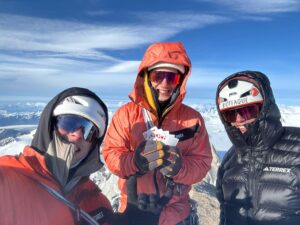There’s a tradition of improvisation on Mount Dickey in Alaska’s Ruth Gorge. Season after season, the mountain’s mile-high granite faces draw the planet’s best climbers. And season after season, these visitors watch their main objectives evaporate as Mother Nature forces them to obey.
That doesn’t mean they fail.
Tom Livingstone and Gaspar Pintar are the latest pilgrims in the Mt. Dickey saga. The Great Wall (ungraded as of this writing) slices across lower slabs and up a tenuous couloir to the 2,909m summit. It’s an unconventional line on the mountain’s often-overlooked south face.
View this post on Instagram
Its features attracted Livingstone and Pinter as soon as they arrived in the Gorge, but amounted to Plan B. Originally, they had set their sights on the classic east face route Blood From the Stone — but it didn’t give passage.
“When we swung our axes into what we hoped was ice, we found mostly unprotected sugar snow,” Livingstone wrote on Instagram. He noted other routes stopped them with similar obstacles.
Bad rock, few routes
Pivoting, he and Pintar refocused on the south face. It’s famous for bad rock and generally bereft of routes. But the climbers noticed an opportunity.
“Crazy slabs” protected the couloir and summit access, Livingstone wrote. But the climbers made a bid anyway.
“Many pitches looked improbable, always tricky. The weather was fickle, but we got lucky,” Livingstone reported. “A subtle traversing line up steep rock led us to the middle of the face, pumpy ice, and a cave bivy. Then we zigzagged higher as snow fell (or rather, rose in the updraft).”
Another marginal bivy on a “snow arete” led to pitches of overhanging neve to the top. In their weeks-long stay, this would be the only summit the two touched.
“Conditions seem ‘bad’ this year but we’re happy to have made the most of it,” Livingstone commented — a takeaway that falls directly in line with the recent history of Ruth Gorge climbing.
Failure or opportunity?
For an adroit alpine climber, Blood From the Stone (1,524m, A1 M7+ WI6+X) is a juicy prize. That’s part of the reason Sean Easton spent multiple seasons establishing it with the likes of Ueli Steck. Deterred over and over by ephemeral ice, Easton finally broke through in 2002 with Steck.
The threshold was thin, even though both climbers were at the height of their fitness. (Steck was fresh off his groundbreaking Eiger solo.) Each man took lead falls that would unnerve the masses, and Easton published a breathy report in the American Alpine Journal.
“With moments of doubt, we had ventured forth without certainty…and the path had unwound before us,” he said.
Thin ice and outright difficulty combined to prevent a repeat for over two decades. Livingstone and Pintar are not the first Blood hopefuls to abandon the route and create their own. Alan Rousseau and Jackson Marvell followed the same blueprint to stamp out Ruth Gorge Grinder (1,524m, AI6+ M7 A1) in 2019.
View this post on Instagram
“A pitch and a half up [Blood From the Stone], it became obvious to me there was not enough ice on the route to safely continue,” Rousseau wrote. “If we didn’t feel defeated enough already in that moment, as we rappelled back to the bivy, we saw two ravens fervently tearing through Jackson’s bag of stashed food.”
Defeat, shmefeat. Marvell and Rousseau returned to the Ruth with Matt Cornell in 2023. Another new east face line, Aim For the Bushes (1,600m, AI6 M6X) resulted.
View this post on Instagram
In the Ruth Gorge, one thing’s clear: Just because a rope team backs off doesn’t mean they’re out of the fight.
“In total, we tried six routes,” Livingstone said of his and Pintar’s trip, “staying busy and psyched! Hats off to folk who’ve climbed routes here.”






